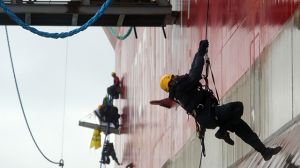
Greenpeace activists including Executive Director of Greenpeace International, Kumi Naidoo, board energy giant Gazprom’s Arctic oil platform Prirazlomnaya off the North-eastern coast of Russia in the Pechora Sea on Aug. 24, 2012. (AP Photo/ Denis Sinyakov, Greenpeace)
One of the main messages in this year’s tour de force, Selma, is that for nonviolent protest to work, activists must be willing to put their bodies on the line. One organization working in that tradition today is Greenpeace International which is known for its controversial, dangerous campaigns to ‘bear witness’ in taking action against environmental degradation. And like Martin Luther King Jr. in Selma, Kumi Naidoo, the head of Greenpeace International, has put himself in harm’s way to fight for what he believes.
“On a daily basis Greenpeace activists and other environmental and social activists standing up for a more just, equitable and sustainable world are putting their lives on the line,” Naidoo tells Moyers. So much so that Naidoo sometimes put his own life in danger, as part of his mission to “lead from the front.”
In this clip, Naidoo recalls his (highly rational) fears as he hung from the side of an offshore oil rig in the Arctic operated by Russian state energy giant Gazprom in 2012. While he endured blasts of cold water hosed at him for hours Naidoo says he thought of his daughter, who urged him to take the job with Greenpeace in the first place.
Watch the clip:
Playing Political Poker with the Planet
Naidoo talks about how he interpreted President Obama’s campaign rhetoric on the environment and why he’s not concerned about Planet Earth but for our children and grandchildren’s futures.
Watch the clip:
Be sure to watch Bill’s full interview with Kumi Naidoo.
TRANSCRIPT
Video: Greenpeace International Director on Why He Puts his Life on the Line
BILL MOYERS: Tell me why you decided to board a rig and put yourself in harm’s way.
KUMI NAIDOO: I feel that on a daily basis Greenpeace activists and other environmental and social activists standing up for a more just, equitable and sustainable world are putting their lives on the line on a regular basis. I mean, at any given time Greenpeace is taking some action to protect the environment somewhere in the world. And I believe that one of the important things about leadership is that if you are leading a movement or an organization, leaders must periodically lead from the front.
It’s not as if given the complexity of my job, I can be taking part in actions every other month or week. But from time to time, it’s important for leaders to say, “I am no more important than you are. My life is no more important than you are.” And if you, as a young person, are taking risks, then I’m also prepared to take that risk.
And just to be clear, what happens if you fall into the ocean. If you fall into the Arctic Ocean with normal clothes or even if you had a, you know a decent swimsuit or even a bodysuit, which was not specifically prepared, you will be dead in about three or four minutes. That’s how cold the water is. We have some protective gear, which will allow you to survive for maybe about two hours. So last year when we were on the Gazprom rig, the same rig where my colleagues who have been arrested now have faced, there were people who were spraying us directly.
And I was in a little sort of what’s called a portal ledge, which is a little tent on the outside with a 25-year-old amazing American young man called Basil. And with a 64-year-old Canadian. The three of us were in this. And for close to 20 hours, we were being sprayed.
And I have to say, that was extremely scary because if we fell, we would’ve hit– fallen about 50 meters down. And we would’ve hit the concrete that is at the bottom of the rig. And in fact, the captain of our ship is saying to the captain of the rig, “Please stop. Their lives are in danger. They’re going to fall. This will be the consequences,” and so on. And then the captain of the rig is saying, “We’ve stopped the hoses. They’d better get off in five minutes, otherwise we are going to start spraying. And yes, we expect they will fall and it’s going to be very dangerous for them.”
BILL MOYERS: What wasn’t recorded was what you were thinking, what was going through your head at that time.
KUMI NAIDOO: You know, to be honest, I was extremely scared. I was thinking a lot actually of my little daughter. You know, my daughter was– I say little, but she just turned 21. But, you know, because I’m with Greenpeace partly because of her because when Greenpeace approached me to consider this position, I was in the middle of a hunger strike. Actually, I was 19 days only on water.
It was a campaign to put pressure on my government in South Africa not to protect the dictatorship of Robert Mugabe in Zimbabwe and to stand up against the human rights violations that were happening to the Zimbabwe people. And Greenpeace calls me on the nineteenth day to say, you know, “Would you consider being a candidate?” And I said, you know, “Thank you very much, but I can’t make such a big decision in the state that I’m in at the moment, having been out here for–”
BILL MOYERS: Fasting, hungry?
KUMI NAIDOO: Yeah, just on water for 19 days. And then my daughter said, “What did Greenpeace want?” I told her. And then she said, “Dad, I won’t talk to you if you don’t seriously consider this position when you finish your stupid hunger strike.” And I said, “Why?” And then she said, “Greenpeace is about my future. This planet is being destroyed. And Greenpeace is not like some other organizations that talk too much and don’t act. At least Greenpeace is prepared to put their lives on the line.” And so that was a major, major motivation. And I’m sitting there, I’m thinking, “Well, my darling, if I fall and break my neck and die here, I hope you remember you told me to do it.”
BILL MOYERS: Interesting because I brought with me a very recent report from UNICEF just out. The study’s titled “Climate Change: Children’s Challenge.” And the report argues that children bear the brunt of climate change, even though they are the least responsible for it. And that they are passionate and vocal, as your daughter was, about the need for action.
KUMI NAIDOO: Absolutely right. Everywhere in the world I go, from the United States to China, young people get it, they’re concerned. They understand that we are running out of time. And they believe more and more that the current adult leadership of the world is betraying their future.
But I want to believe that there is enough humanity in all of us that even the CEO of a coal company, an oil company or a gas company can actually– fossil fuel companies, have children and grandchildren. And I’m constantly in my conversations with the leaders of the fossil fuel companies, as well as other polluting companies. I’m saying to them, “Listen, put your children and your grandchildren’s future in the middle of this conversation.” And I think history is going to judge this generation of adult leaders extremely harshly because, you know, maybe 30 years ago you could say we didn’t know, the climate science was not so clear and so on. Today there is no excuse for not taking bold, urgent action.
Video: Playing Political Poker with the Planet
KUMI NAIDOO: ….when President Obama was running for election there were three phrases that resonated with us, which he used multiple times in all his regular stump speeches, right? “Yes, we can,” “the fierce urgency of now,” which is a phrase from Martin Luther King, and “a planet in peril.”
BILL MOYERS: In peril?
KUMI NAIDOO: Yeah. We understand a planet in peril was our understanding that climate change was actually threatening this life on this planet as we know it. Now, if you take something like Hurricane Sandy, right, Hurricane Sandy would’ve happened. Hurricanes happen. But you have to look at the intensity, the height of the waves and so on, which is compounded by the impacts of climate change, with regard to already you know, the sea level rise that we’ve seen, a warming ocean and so on. So we must be very clear.
We are playing political poker and commercial poker with the future of the planet. And when you say, “future of the planet” we’re talking about the future of children. You know, the one thing I jokingly say, you know, sometimes people say, “Save the planet, save the climate and so on.” I say, the planet actually does not need any saving. The planet’s going to be here. And actually, the reality is if all of us warm this planet and destroy it and we all cannot survive here anymore, the planet will replenish.
BILL MOYERS: It will come back.
KUMI NAIDOO: What is at stake is humanity’s ability to live in coexistence with nature for centuries to come. And there can be no more important ethical imperative for any political or business leader than saying, “I have a responsibility to act in a way that does not imperil my children and grandchildren’s future.”



